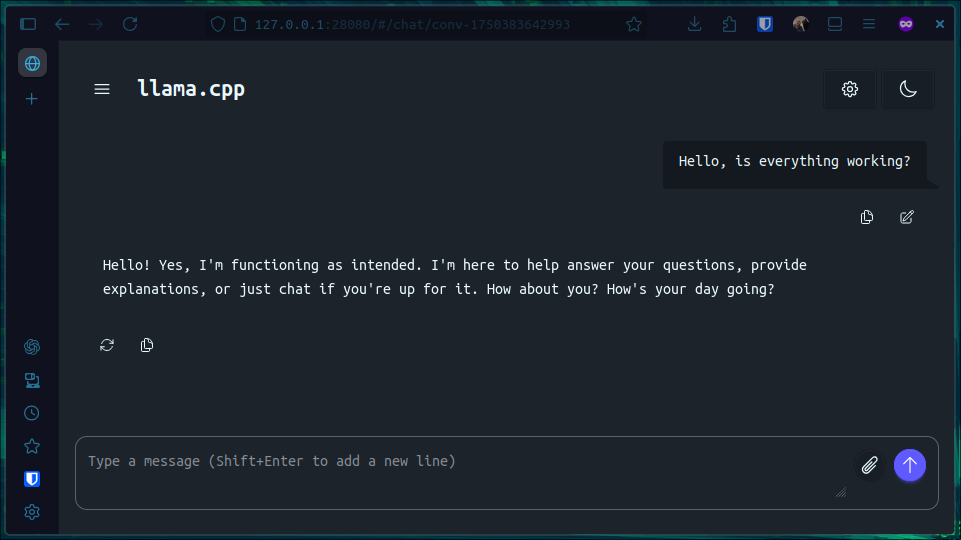Running Local LLMs (“AI”) on Old AMD GPUs and Laptop iGPUs (Arch Linux Guide)
A straightforward guide on how to compile llama.cpp with Vulkan support on Arch Linux (and Arch-based distros like CachyOS, EndeavourOS, etc). This lets you run models on old, officially unsupported AMD cards and Intel iGPUs.
The same steps work on Debian/Ubuntu, but the package names are different.
Here’s how I’m running models on 3 × AMD Radeon RX 580 8 GB (24 GB VRAM total) without ROCm in 2025.
1. Preparation
1.1 Install Required Packages
yay -S git vulkan-devel vulkan-headers spirv-headers cmake ninja gcc python python-pip python-wheel python-setuptools
1.2 Get the Source Code
Clone the llama.cpp repo:
git clone https://github.com/ggml-org/llama.cpp.git
2. Compile and Install
2.1 Compile llama.cpp with Vulkan Support
Go to the cloned repo:
cd llama.cpp
Run cmake with Vulkan enabled (-DGGML_VULKAN=1). The -DCMAKE_INSTALL_PREFIX=/opt/llama.cpp flag decides where binaries get installed – don’t forget to add it to your $PATH later.
cmake -S . -B build -G Ninja -DCMAKE_BUILD_TYPE=Release -DCMAKE_INSTALL_PREFIX=/opt/llama.cpp -DLLAMA_BUILD_TESTS=OFF -DLLAMA_BUILD_EXAMPLES=ON -DLLAMA_BUILD_SERVER=ON -DBUILD_SHARED_LIBS=OFF -DGGML_VULKAN=1
Example output:
-- The C compiler identification is GNU 15.1.1
-- The CXX compiler identification is GNU 15.1.1
...
-- Build files have been written to: /home/albin/Git/llama.cpp/build
Compile with as many threads as you have CPU cores:
number_of_cores=12 # Set this to the number of CPU cores on your system
cmake --build build --config Release -j $number_of_cores
[0/2] Re-checking globbed directories...
[9/177] Performing configure step for 'vulkan-shaders-gen'
...
[176/177] Linking CXX executable bin/llama-server
2.2 Install the Binaries
Install your freshly built binaries:
sudo cmake --install build --config Release
-- Installing: /opt/llama.cpp/lib/libggml-cpu.a
-- Installing: /opt/llama.cpp/lib/libggml-vulkan.a
-- Installing: /opt/llama.cpp/bin/llama-server
...
2.3 Add llama.cpp to Your $PATH
/opt/llama.cpp/bin needs to be in your $PATH.
2.3.1 Bash
micro ~/.bashrc
Add this line at the end:
export PATH="$PATH:/opt/llama.cpp/bin"
Apply it:
source ~/.bashrc
2.3.2 Zsh
micro ~/.zshrc
Add:
export PATH="$PATH:/opt/llama.cpp/bin"
Apply:
source ~/.zshrc
2.3.3 Fish
set -U fish_user_paths /opt/llama.cpp/bin $fish_user_paths
2.4 Test the Installation
Check that the binaries are on your path:
which llama-server
Should print:
/opt/llama.cpp/bin/llama-server
3. Running llama-server
Check which Vulkan devices are found:
llama-server --list-devices
Example output on my Intel-based laptop:
ggml_vulkan: Found 1 Vulkan devices:
ggml_vulkan: 0 = Intel(R) Graphics (MTL) ...
Available devices:
Vulkan0: Intel(R) Graphics (MTL) (47814 MiB, 47814 MiB free)
3.1 Download a Model
Any GGUF file from Hugging Face works, but here’s an example with Dolphin Mistral 24B Venice Edition (6-bit quantized):
cd ~/Downloads
wget "https://huggingface.co/bartowski/cognitivecomputations_Dolphin-Mistral-24B-Venice-Edition-GGUF/resolve/main/cognitivecomputations_Dolphin-Mistral-24B-Venice-Edition-Q6_K.gguf"
3.2 Start the Web Server
To make the server available on your whole LAN (port 28080):
llama-server --host 0.0.0.0 --port 28080 --model cognitivecomputations_Dolphin-Mistral-24B-Venice-Edition-Q6_K.gguf
You should see a big log dump ending in something like:
main: server is listening on http://0.0.0.0:28080 - starting the main loop

And voilà – everything should work!
4. Tweaking and Autostart: Running as a Service
4.1: Launch via Shell Script
To avoid typing that massive command every time (and for saner logs), use a script. Here’s an example for my setup (3 × RX 580):
#!/bin/bash
MODEL_PATH="/mnt/nas.models/cognitivecomputations_Dolphin-Mistral-24B-Venice-Edition-Q6_K.gguf"
HOST="0.0.0.0"
PORT="8080"
CTX_SIZE="2048"
GPU_LAYERS="999"
BATCH_SIZE="256"
THREADS="12"
VULKAN_DEVICES="0,1,2"
LOGFILE="/var/log/llama-server.log"
if [ ! -f "$MODEL_PATH" ]; then
echo "❌ Model file does not exist: $MODEL_PATH"
exit 1
fi
echo "🚀 Starting llama-server with Vulkan and RX 580 x3..."
echo "🧠 Model: $MODEL_PATH"
echo "🌐 Listening on: $HOST:$PORT"
echo "🎮 Vulkan devices: $VULKAN_DEVICES"
echo "📏 ctx-size: $CTX_SIZE | 🧮 batch-size: $BATCH_SIZE | 🧠 GPU-layers: $GPU_LAYERS"
echo "📃 Logging to: $LOGFILE"
/opt/llama.cpp/bin/llama-server \
--model "$MODEL_PATH" \
--ctx-size "$CTX_SIZE" \
--host "$HOST" \
--port "$PORT" \
--gpu-layers "$GPU_LAYERS" \
--batch-size "$BATCH_SIZE" \
--threads "$THREADS" \
--api-key secret-api-key \
>> "$LOGFILE" 2>&1
4.2: Run on Boot with systemd
- Save the script above as
/home/<your-user>/scripts/start-llama-serverand make it executable. - Create your systemd service file:
sudo micro /etc/systemd/system/llama-server.service
Paste:
[Unit]
Description=Llama Server
After=network.target
[Service]
Type=simple
User=your-user
Group=your-user
ExecStart=/home/your-user/scripts/start-llama-server
Restart=on-failure
RestartSec=5
WorkingDirectory=/home/your-user/scripts
StandardOutput=append:/var/log/llama-server.log
StandardError=append:/var/log/llama-server.log
[Install]
WantedBy=multi-user.target
Note: Replace
your-userwith your username.
- Enable and start the service:
sudo systemctl daemon-reload
sudo systemctl enable --now llama-server
- Watch logs in real time:
tail -f /var/log/llama-server.log
Conclusion
Congratulations! You now have the power of LLMs running on “crap” hardware. Go do something weird.